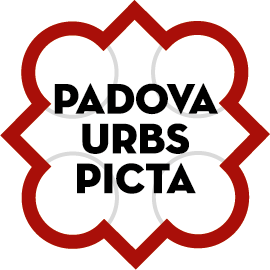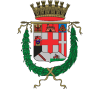This walk starts from the central Piazza Garibaldi.
Extending to the west of the piazza, the area between Via Santa Lucia, Via San Fermo and Via Dante was, up to around 80 years ago, occupied by the very lively Contrada di Santa Lucia, which was the only extant medieval district in Padua. Comprising old buildings, lively streets and venerable historical monuments, this covered a total of 20,000m2. However, nearly all this would be swept away in the years after 1926 because of an unchallenged decision by the local council to bulldoze through the area to create a more fluid road link that ran through Porta Savonarola to connect the centre of the city with the Padana Superiore (a main road to the west). The plan was also intended to create a prestigious ‘modern’ urban district comprising what is now Piazza Insurrezione (then Piazza Spalato), together with Via Verdi, Via Risorgimento, Via Bajamonti and Largo Europa. The demolition work proceeded very quickly, and very few of the buildings survived. Roberto Papini, in the 1920s General Director of Italy’s Art Schools, would write in the national newspaper Il Corriere della Sera (3 November 1927): “All mutual understanding has gone. The demolishers are victorious, razing the Santa Lucia district to the ground, devastating everything, flattening all of Padua. [And this is the city] that is a gem of calm intimacy, whose twisting streets, lined with squat porticoes and simple and serene homes, were the model of domestic housing that architects from Germany and Holland came to study when developing the very latest in modern architecture…” The architectural historian Giuseppe De Fabris had this to say about the results of this ‘redevelopment’ in 1977.
“Three buildings of great historical significance were lost forever. The house of Pietro d’Abano, one of the leading lights of Padua University during the Renaissance, which was located in Via dei Dotto (the present-day Vicolo dei Dotto running between Via Dante and Piazza Insurrezione); the house where that glory of Italian art, Andrea Mantegna, grew up (located between the old Via Calatafimi and Via Pietro d’Abano, on a site opposite the 1936 Camera di Commercio building, designed by Gino Miozzo); the house next door to the Mantegna house, which was the family home of Girolamo Savonarola.” Walking down the present-day Via Santa Lucia you come at number 9 to the vast facade of Palazzo Valvassori, and at number 29-33 to an early-fourteenth-century building, complete with a high portico. At number 37-39, coinciding with Via Marsilio da Padova, is what is presumed to be the house of the tyrant Ezzelino the Terrible; this has a fifteenth-century three-light window, two two-light windows on the upper storey of the south facade, and bears a plaque with an inscription by Carlo Leoni. In the fourteenth century this Romanesque building was actually occupied by the Carraresi family, and would subsequently undergo extensive alterations, as well as being damaged by a fire in 1726. The facade arch is known as both the Volto dei Milanesi and the Volto della Malvasia (the latter probably because of the presence here of an inn selling Malvasia wine from the Greek islands). The rooms above that arch once housed the Teatro di Santa Lucia (1794-1873), where performers included Giacomo Bonfio, a very popular playwright and performer (1781-1855), and the Polish Fanny Sadowski (1826-1906); she debuted here when only 15 years old and would subsequently perform at the Teatro Concordi (later converted into a cinema, which is now disused). To the right of the building is Via Flavio Busonera (the old Via Calatafimi). A plaque recalls that Flavio Busonera, a physician and patriot, was hanged here by the Nazis on 17 June 1944; he is buried the monumental cemetery of Chiesanuova, which is also the burial place of Antonio Pedrocchi and Domenico Cappellato Pedrocchi (Café Pedrocchi is a legendary establishment in the city centre). Continuing down Via Santa Lucia, you come – on the right – to Via Martiri d’Ungheria (the old Via Borromeo). Here stands the church of Santa Lucia (which is also known by the name of Corpus Domini), a religious foundation which is first mentioned in records dating back to 964.
By 1221 the house of worship was already being mentioned as a ‘chapel’, and would become a parish church in 1308. The collapse of the bell-tower in 1634 severely damaged the structure, which then underwent successive campaigns of reconstruction, the most extensive being completed in 1711-1726; the plans were drawn up by the architect Girolamo Frigimelica, whilst the actual execution of the work – especially that on the facade – was entrusted to his pupil Sante Benato. On the exterior, the two side doors of the facade are surmounted by eighteenth-century statues depicting St. Peter and St. Paul, whilst the interior is a single nave ending in a presbytery. The works of art here include paintings by Gian Battista Tiepolo, Sassoferrato, G. Ceruti and Il Padovanino, sculptures by Giovanni and Antonio Bonazza and a marble bas-relief of “The Church at Prayer before the Glory of God” by Amleto Sartori (on the high altar). On the space in front of the church is a ‘column’ in trachyte stone with a votive cross, which was raised in 1839 in honour of the great preacher Abbot Giuseppe Barbieri. To the right of this open space is the Oratory of San Rocco. The Confraternity of San Rocco having acquired premises for their chapter meetings in 1476, work on the present building would begin in 1525; the interior has frescoes with Scenes from the Life of San Rocco by the Paduan artists Gualtieri, Stefano Dell’Arzere, Girolamo dal Santo, Girolamo Tessari and Domenico Campagnola. On the high altar is a fine altarpiece of Madonna and Saints by Alessandro Maganza. Now deconsecrated, the Oratory is the property of Padua City Council and is used to host various events. At this point, on the left side of the street, are Via Stefano Breda (the old Via Calatafimi) and Via Pietro d’Abano (formerly Via Figaro and also known as Androna di Santa Lucia).
To the south, in the Arch of Santa Lucia (also known as the Abbey Arch or the Holed Arch), you can see on the left the typical bussola [opening] that used to serve to communicate with the rooms above- At number 67-73 is the Casa Dondi, which dates from the thirteenth-fourteenth century and was home to the priests of the parish of Santa Lucia from 1496 to the eighteenth century; note the two-light window on the internal facade. The two houses to the right were, from 1509 to 1771, home to the Collegio Lambertino (also known as the Brescian College); this was founded by the Brescia-born physician Girolamo Lamberti for students from noble families in his home city. The plaque on the facade is practically illegible.
At number 77, on the corner with Via Boccalerie (whose name comes from the presence here once of pottery workshop), stands a fourteenth-century brick-built house, complete with cornice and projecting barbicans. Opposite the entrance to Via Boccalerie is Via Aquileia (formerly Via Cavarene-Capraie), with, on the right, a tall tower-house of exposed brick designed by the engineer Ettore Munaron. On the left, at number 7, is the building which houses the Superintendence for Archaeology in East Veneto; this is known as “the fig house” because of a fig plant that once grew from between the bricks of the facade. Coming back to Via Santa Lucia and continuing down it, on the left is Via Belle Parti; it is said that the name (‘fine area’) indicates that this was the first street to see the construction of masonry-wall housing in the Middle Ages. Continuing on, at number 87 (when this stretch of the street was actually Via del Pero) lived Vittorio Polacco (1859-1926), a professor of Civil Law and Chancellor of the University. To the left, in Via Nazario Sauro (formerly Via del Pozzetto) there is a fine sixteenth-century palazzo at number 15-17.
Coming back to Via Santa Lucia and continuing down the last stretch (which was once called Via Bolzonella), you come to the corner of Via Nazario Sauro; the corner house here was restored in 1847 by the architect Giovanni Battista Trevisan.












